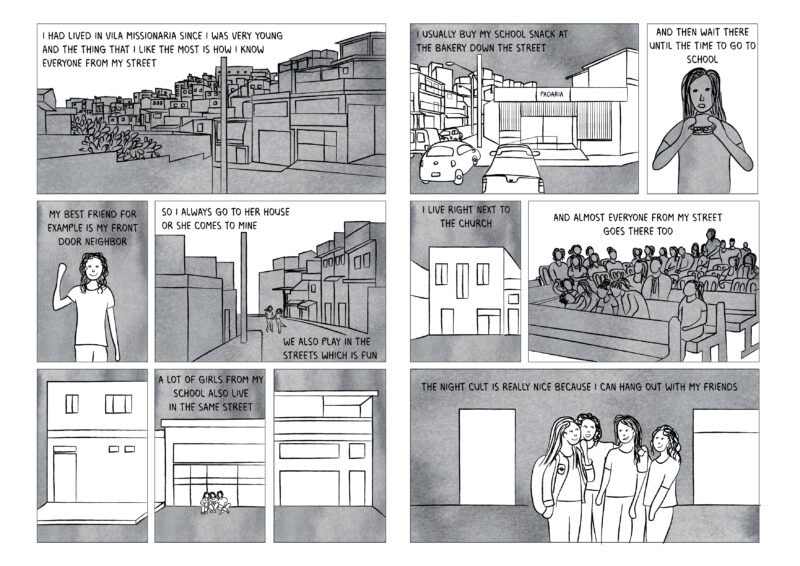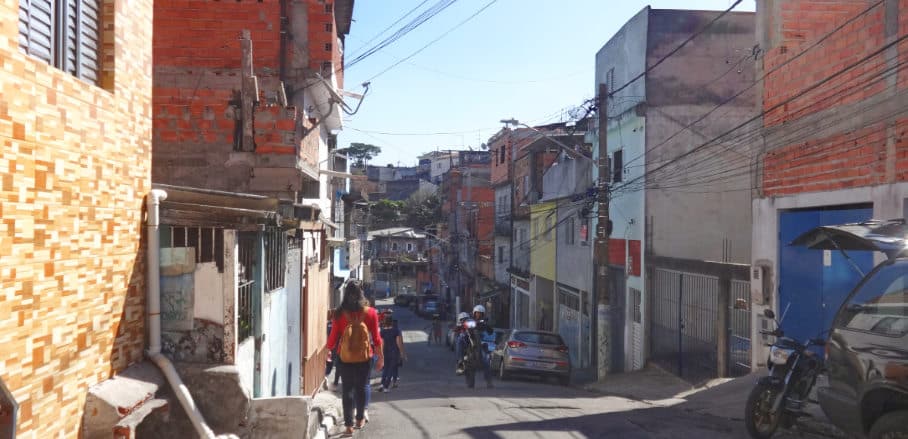Digital Surveys to Access Marginalised Views in Favela Communities
The study of favelas has been characterised by traditional methods, usually consisting of paper-and-pen interviews and field research. Recent studies suggest that digital platforms are a convenient way to access marginalised populations. Maria Luisa Tarozzo Kawasaki shares her experiences with digital surveys in São Paulo’s favela Vila Missionaria and explains how they caused her to develop Neibz, a software tool for urban data surveying.
The Challenges of Studying a Favela: A Walk Through Vila Missionaria
Vila Missionaria is situated in São Paulo city. Walking through the neighbourhood, you can see many locals sitting on doorsteps, staring at you with curiosity as they recognise you as an outsider. It’s easy to get lost inside Vila Missionaria; most of the buildings look the same and the streets don’t follow any planned structure. You feel like you’re inside a maze. The irregular morphology typical of favelas can act as a barrier to traditional forms of mapping and studying urban spaces; aerial data collection, for example, tends to suffer from occlusions and fails to capture the typical heterogeneity in material and design.
Our guide through the favela was twelve years old. She started off the tour by showing us her school. The school’s sports field is the only one of its kind in the whole neighbourhood, and some children who attend a different school come to play here. The definition of public space inside favelas is often atypical and difficult to map.
This type of local knowledge is able to fill the gap in information regarding favelas. How do young people experience irregular urban settlements? What can they observe that maybe was not mapped before? Quoting Michael F. Goodchild, “citizens are sensors”, and their local observations are extremely valuable when studying cities, especially where access to a space is limited.
Sometimes our guide would attend parties near Vila Missionaria on the weekends. When asked if the parties were open to outsiders, she just shook her head. There are places within favelas that are inaccessible to outsiders and often dangerous for researchers. Janice Perlman, the famous author of ‘The Myth of Marginality’, stated regarding how to avoid the risk of studying favelas: “The ubiquity of cell phones should make that much easier today.” This advice reflects the potential of portable devices to access these communities. Can our cell phones be a way to study these hard-to-reach spaces?

Results of the survey are represented in a graphic novel © Maria Luisa Tarozzo Kawasaki
The Use of the Internet and Social Media Among Young People in Favelas
At Vila Missionaria, topics like TikTok trends and make-up YouTube channels are typically overheard in young girls’ conversations. A study conducted in 2012 found that nine out of ten residents under thirty years old in the favelas of Rio de Janeiro had access to the Internet. In an interview from a 2019 study undertaken in Morro dos Prazeres, a favela in Rio de Janeiro, a local stated: “[…] everyone has a smartphone, the poorest guy has a smartphone”.
Of the residents who have access to the Internet, 85 per cent have a Facebook account, according to the research institute Instituto Data Favela. The significant proportion of the favela population with access to the Internet increases the potential of digital tools to connect researchers and residents. Local knowledge can become visible and the study of cities can become more participative.
Accessing Vulnerable Communities Through a Digital Survey: The Vila Missionaria Experience
To explore this hypothesis more in-depth, a series of interviews were conducted online. Interviewees, young girls aged nine to twelve years old, were living in Vila Missionaria or in a nearby area. They were asked to describe how they perceived the neighbourhood where they live. The girls shared pictures and voice messages describing their daily lives in the favela. This digital survey became a window to how a young person would experience Vila Missionaria.
A finding of the study is that the identified beneficial spaces were usually school sports fields that were also open during the weekends and religious spaces. These are areas that, from an outsider’s perspective, might not have been mapped as spaces frequently used by young girls, if it wasn’t for the local knowledge of the volunteers. To make the outcomes of the research available to the interviewees, a graphic novel was produced using the results.

Neibz © Maria Luisa Tarozzo Kawasaki”
Neibz: Creating a Tool From the Experience at Vila Missionaria
The successful experience of using digital surveys while studying Vila Missionaria led to the development of Neibz, a software tool used to collect the data needed while studying a neighbourhood. The survey can be accessed through a website and is available on mobile devices. The interface is similar to an app but does not require to be downloaded on mobile phones. Using six different categories, namely primary and secondary services, security, health, mobility, and sustainability, the results are presented as a spiderweb with different scores per category, making it easier to interpret the results. Both categories and questions can be modified by researchers and different studies can be conducted simultaneously. The results of different studies can also be compared easily.
The results are stored, and the database is organised in years, making it possible to compare scores over time. This facilitates the follow-up, for example, of an urban intervention. In 2020, Neibz won the Future Cities Challenge by UN-Habitat and Fondation Botnar. The software is part of an ongoing research project by the author regarding the applicability of Neibz and other forms of geo-data visualisation.
The experience at Vila Missionaria made it clear that locals with access to the Internet can add valuable information to urban research. Digital surveys proved to be a way to not only facilitate the process of surveying itself but, in the case of marginalised populations, the access to the Internet can present a window to realities that were never mapped before.
- Digital Surveys to Access Marginalised Views in Favela Communities - 4. August 2022
